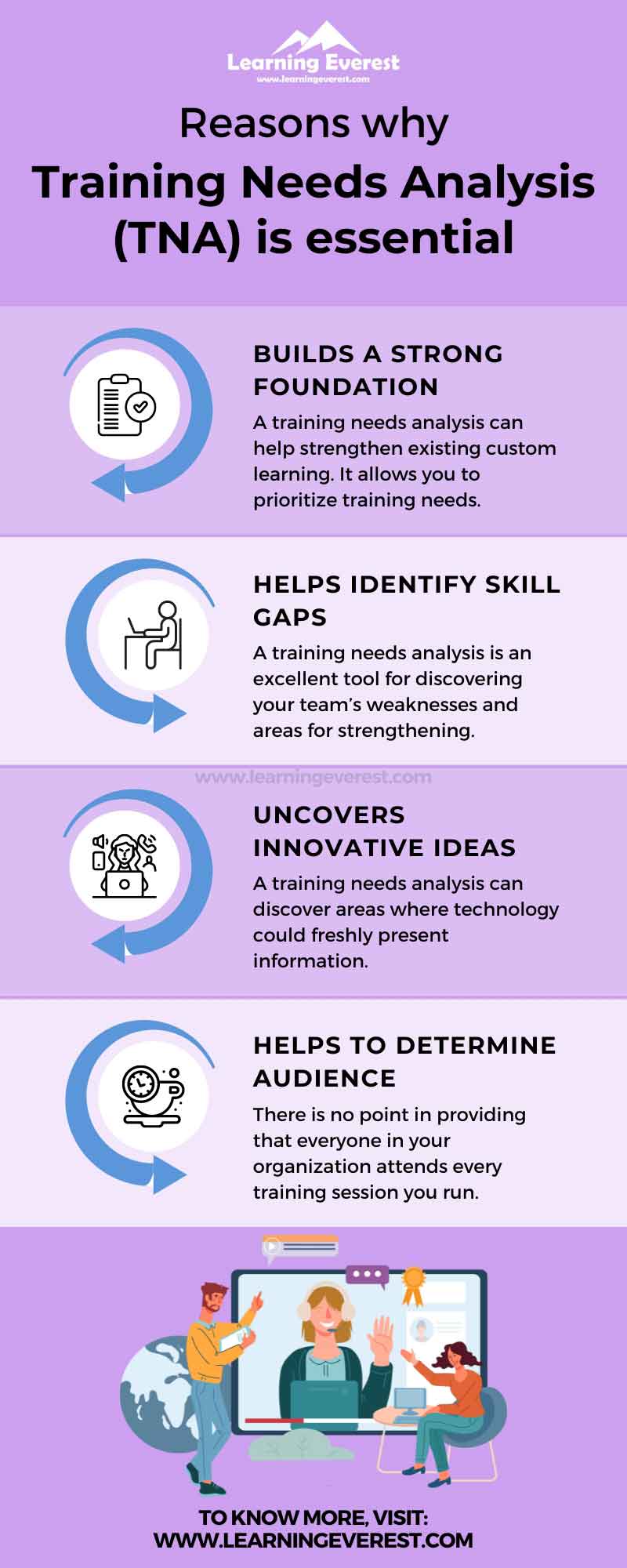Often, employers tend to believe that they know what the employees need to know, but there can be gaps in their knowledge. A training needs assessment helps validate the training requirement. Training needs analysis (TNA) identifies the need for training. Training needs analysis (TNA) gives a structure to the program conducted through a series of analyses. The analysis helps to complete the training program structurally. By conducting a training needs analysis (TNA), you can have the following advantages:
Table of Contents
Here are six reasons why training needs analysis (TNA) is essential for L&D programs
Build a strong foundation
A good foundation for a training program is fundamental if you start from scratch, but a training needs analysis can help strengthen existing custom learning. It allows you to prioritize training needs. Most organizations find it challenging to plan training programs – it is hard to decide which training is the most important. By using a training needs analysis, you will be able to determine the training which needs to be completed as soon as possible and which training program can be left till later in the year.
When the training has a strong framework, it will be more effortless to scale as your organization grows. Before a training program starts, this analysis will help you to determine which policies, skills, and resources employees need. Then, the training program can focus on the most critical topics. It acknowledges performance goals and the knowledge, skills, and abilities required for the workforce to achieve the desired goal.
Help identify skill gaps
One significant benefit of completing a training needs assessment is that it can help you and the employee identify any knowledge and skills gaps before it becomes an issue and negatively impact the business and/ or the individual. A training needs analysis is an excellent tool for discovering your team’s weaknesses and areas for strengthening or reskilling. The process helps determine where the L&D team should distribute a training budget and finds areas where they need additional assistance to retain what they have learned.
Uncover innovative ideas
Organizational training can become outdated fast. New technologies become available from one iteration to the following, and research brings fresh data to the market. A training needs analysis can discover areas where technology could freshly present information. A training needs analysis could highlight areas your L&D team needs training on that you never even considered. Without the use of a training needs analysis, you may never have considered a certain area of training, which could have severely affected your business.
Completing a training needs analysis will therefore allow organizations to see exactly what you need to focus on in corporate training. At the same time, it will also highlight the areas your team does not need any further training on.
Help to determine who needs training
Determining who needs training is essential in planning training. The key is to ensure that the right employees are in the right training sessions. There is no point in providing that everyone in your organization attends every training session you run. This approach led to disengagement and demotivated employees. The employees will only be engaged in training sessions if they frequently attend training that is useful to them. A training needs analysis will allow the organizations to target the right employee for each training program, ensuring everyone gets a personalized training environment to get the most benefit possible.
Inform the scope of your training program
Scoping your managed training program is a step closer to developing and designing training content. A training needs analysis shows exactly the training content you require and the methods that match most with employees who learn in different ways. It helps you avoid a budget inflated with unnecessary features. A well-aligned training needs analysis will recognize if there is a need for an alternative training program or if a whole new solution would be better. It will also determine the proper method of training your employees. It also manages the resources required to fulfill organizational goals, improve productivity, and provide quality products and services.
Prepare for specific job roles
Instead of training every employee in the same way, via a training needs analysis, you can understand which training programs are best for particular positions for a specific employee in a specific role. It lets the employees upskill in their roles at a faster rate and creates significant opportunities for economic mobility.
The abovementioned reasons can help you understand how a training needs analysis (TNA) is essential for L&D programs. But do you know a few other benefits? Are they not listed here? Let us know in the comments below.
Infographic
Knowledge Check!
Frequently Asked Questions (FAQs)
What is a TNA in HRM?
TNA stands for training needs analysis.
Training needs analysis (TNA) identifies the need for training. Training needs analysis (TNA) gives a structure to the program conducted through a series of analyses. The analysis helps to complete the training program structurally.
What is effective training?
An effective training program includes multiple employment opportunities to enhance their job skills.
What is the importance of effective employee training?
An effective training and development program for employees can have numerous short and long-term benefits. It can increase employee engagement and retention rates. It also encourages innovative thinking, mitigates risks, and gives the organization a competitive edge.






